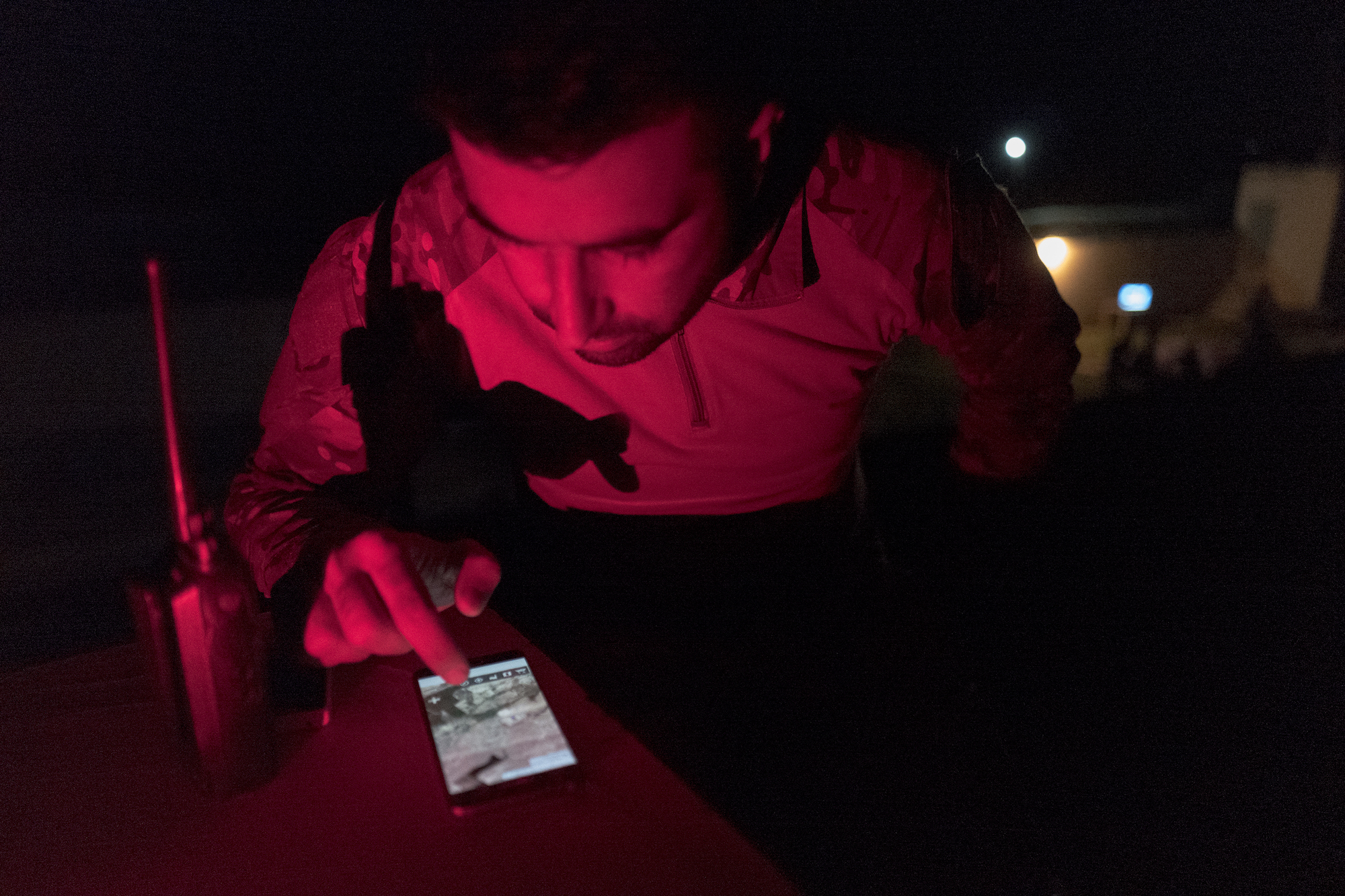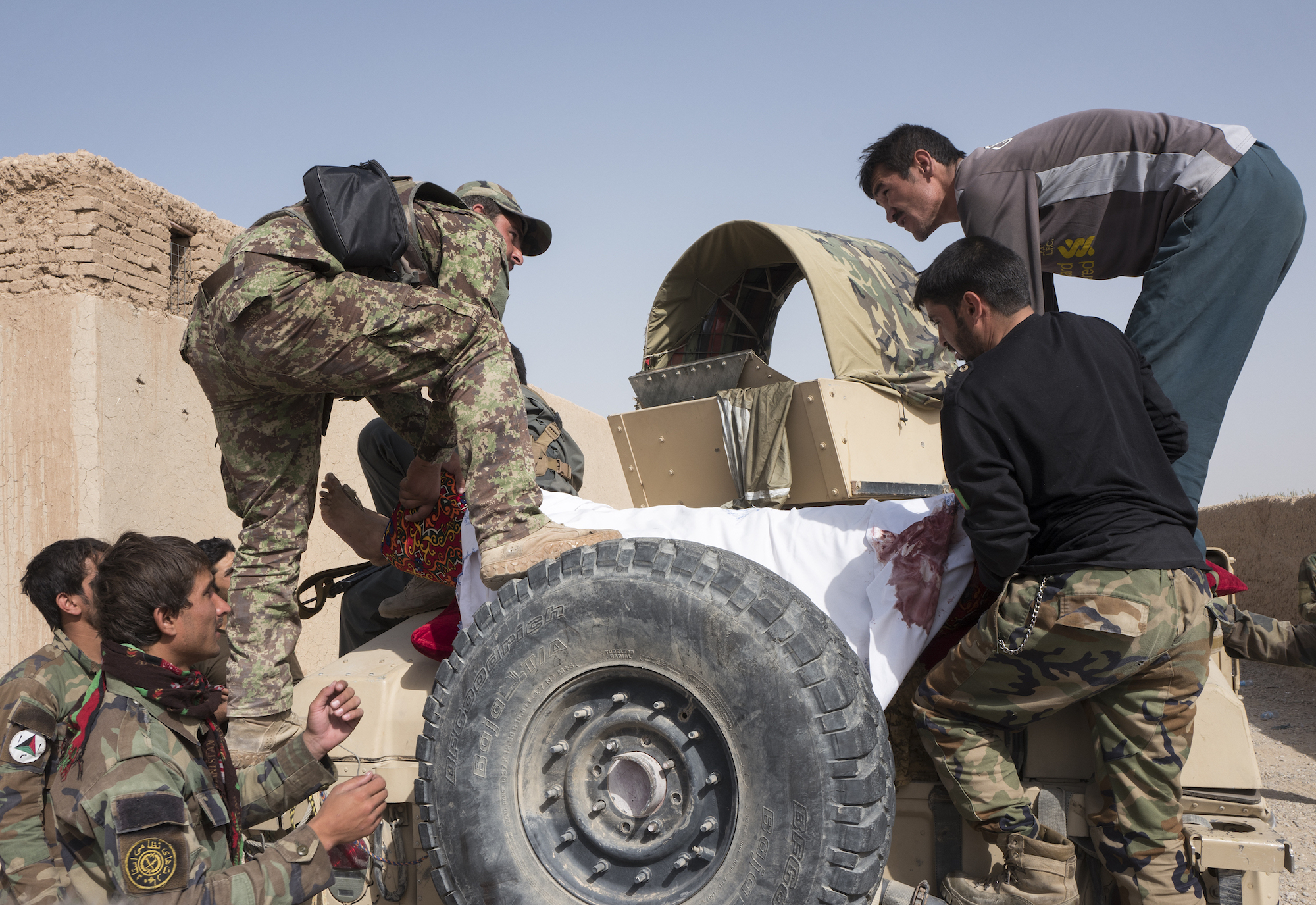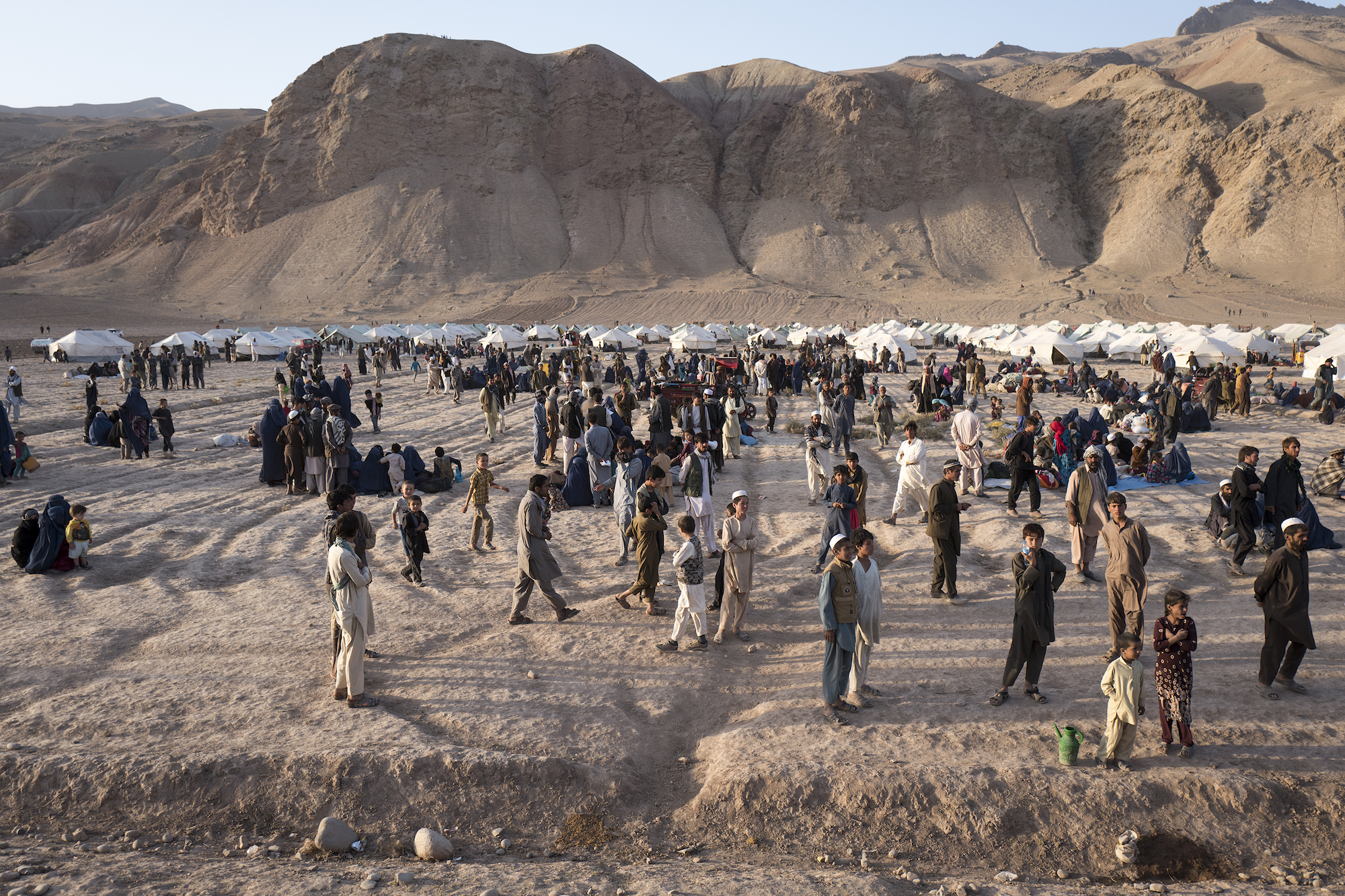Afghan President Ashraf Ghani had just finished receiving his morning briefing last Wednesday when the windows at the presidential palace shattered. The cause: a massive truck bomb, detonated less than 1,000 meters away, during rush hour in the capital Kabul.At least 150 people were killed and nearly 500 more injured, most of them civilians.The blast, which left a crater more than 65 feet wide, took place inside the Diplomatic Zone, supposedly the most secure area in Afghanistan. Two days later, when thousands of Afghans took to the streets to demonstrate against both the Taliban and the government, four people, including an 8-year-old boy, were shot dead by police. The following day, at least seven people were killed when suicide bombers targeted a funeral for one of the protestors.Such attacks have become common over the last few years, and Kabul, once considered a safe haven, is now a battlefield where civilians are regularly slaughtered at random, recalling the darkest days of the civil war.The recent carnage is the latest sign that the already dire situation in the country can get even worse. Since the U.S. military handed security over to Afghan forces in December 2014, the government has rapidly lost territory to the Taliban, who now control or contest 40 percent of the country — more land than they have had since being overthrown in 2001.Nowhere is secure, no one is safe, and there is no end in sight.The U.S., which is still advising, assisting, and funding the Afghan government and its security forces, has called for a greater troop presence to “break the stalemate,” but leaders for the past several years have failed to articulate a desirable or realistic goal. In the past, there was hope that the Taliban would be persuaded through force to negotiate, but today they clearly have the momentum and little reason to come to the table. With no political solution and no prospect of military victory in sight, current policy appears geared toward simply preventing absolute catastrophe. Yet even that grim goal appears increasingly unlikely. Although craven attacks like the latest bombing generate grizzly headlines, the war in the countryside is considerably worse. Nowhere is the complete collapse of Afghanistan felt more than in provinces like Helmand, Paktia, Kandahar, Kunduz, and Khost, where the Taliban are able to not just launch spectacular attacks, but take and hold ground, often seizing large amounts of American-supplied military hardware in the process.Last November, I travelled to several provinces where the Taliban had made significant gains to witness firsthand how bad things had become.Zia Bardar crouched in an irrigation ditch as he dragged a long bamboo stick with a hook taped to the end across the road, looking for one of six IEDs he knew had been placed there. He was wearing a loose-fitting police uniform — but no protective gear.This was Lashkar Gah, the provincial capital of Helmand province, and the Taliban were nearby, shooting at Bardar and his colleagues. Just up the road, a mangled rickshaw burned; it had driven over another IED earlier that morning, killing the family of six who were on board. Police said the family had fled their home and were within half a mile of making it into government-held territory.The police were trying to get to an army base that had been surrounded for four days, where they hoped to collect the body of a soldier and give him a proper burial. The mission offered no tactical gains, but it would make an awful situation a bit less difficult to bear.
Yet even that grim goal appears increasingly unlikely. Although craven attacks like the latest bombing generate grizzly headlines, the war in the countryside is considerably worse. Nowhere is the complete collapse of Afghanistan felt more than in provinces like Helmand, Paktia, Kandahar, Kunduz, and Khost, where the Taliban are able to not just launch spectacular attacks, but take and hold ground, often seizing large amounts of American-supplied military hardware in the process.Last November, I travelled to several provinces where the Taliban had made significant gains to witness firsthand how bad things had become.Zia Bardar crouched in an irrigation ditch as he dragged a long bamboo stick with a hook taped to the end across the road, looking for one of six IEDs he knew had been placed there. He was wearing a loose-fitting police uniform — but no protective gear.This was Lashkar Gah, the provincial capital of Helmand province, and the Taliban were nearby, shooting at Bardar and his colleagues. Just up the road, a mangled rickshaw burned; it had driven over another IED earlier that morning, killing the family of six who were on board. Police said the family had fled their home and were within half a mile of making it into government-held territory.The police were trying to get to an army base that had been surrounded for four days, where they hoped to collect the body of a soldier and give him a proper burial. The mission offered no tactical gains, but it would make an awful situation a bit less difficult to bear. Soon Bardar was laying flat on his stomach, sifting through rubble with his bare hands. I stood next to an armored Humvee that inched along behind while he attempted to locate the explosives. It was the only such vehicle the police had and at least three bullets struck it as I watched Bardar work. He found two of the IEDs immediately, and gently separated the detonating caps from the large yellow water jugs that had been filled with explosive powder. I asked his commander if he had been trained in EOD (Explosive Ordnance Disposal).“Not too much,” he said. “He is the real hero.”Bardar eventually found and disarmed five IEDs, and the police made it to the base, where the dead soldier was loaded onto the back of the Humvee.Like many of his fellow police, tragedy had touched Bardar’s life. Two weeks before I watched him disable an IED with his bare hands, his wife had been shot dead by her own uncle for marrying a policeman, someone who “worked for the infidels.”“My family is finished,” Bardar told me. “It is only me left.”Two days after Bardar cleared the IEDs, the area near the road fell to the Taliban. Squabbling between different units resulted in no one being willing to take up positions to defend the territory.Two days earlier, and just nine miles away, a stolen — or quite possibly sold — government Humvee laden with explosives was driven into a police base; the blast killed the chief along with at least 14 of his men. It was all beautifully filmed by a Taliban drone. Such brazenness is now routine.The Taliban currently control most of Helmand, including districts like Marjah, Sangin, Gereshk, and Garmsir, which U.S. Marines fought for years to win. Thousands of young American men lost their lives or limbs here, and Helmand was the beneficiary of more U.S. dollars and resources than anywhere else in Afghanistan. Today, there is little to show for it all apart from a few tarmac roads.The Afghan National Army and police are currently carrying out nothing more scrambled and often desperate attempts at damage limitation. Only the city of Lashkar Gah, the capital of Helmand province, remains under government control, and while I was there it was regularly attacked from all sides.This year the grim pattern has continued. On April 19, ten men wearing army uniforms and driving army vehicles stormed the main military base in Mazar-i-Sharif and killed 144 mostly unarmed soldiers as they ate lunch or prayed; the Taliban said four of the attackers were former soldiers familiar with the base.Such attacks have only accelerated Afghan defections and desertions that had already reached crippling levels. Last year, 6,800 soldiers and policemen were killed, a 35 percent rise over 2015. It’s a trend that already appears certain to continue this year, and the so-called fighting season has just begun.The Afghan National Security Forces have no chance of winning, and they are only holding on to major cities like Lashkar Gah because of an increase in U.S. airstrikes and special forces operations. But this strategy of military triage has not yet led to increased chances for peace. The countryside is falling and key population centers are being propped up in a series of bloody stalemates that promise to last for years and take thousands of lives.
Soon Bardar was laying flat on his stomach, sifting through rubble with his bare hands. I stood next to an armored Humvee that inched along behind while he attempted to locate the explosives. It was the only such vehicle the police had and at least three bullets struck it as I watched Bardar work. He found two of the IEDs immediately, and gently separated the detonating caps from the large yellow water jugs that had been filled with explosive powder. I asked his commander if he had been trained in EOD (Explosive Ordnance Disposal).“Not too much,” he said. “He is the real hero.”Bardar eventually found and disarmed five IEDs, and the police made it to the base, where the dead soldier was loaded onto the back of the Humvee.Like many of his fellow police, tragedy had touched Bardar’s life. Two weeks before I watched him disable an IED with his bare hands, his wife had been shot dead by her own uncle for marrying a policeman, someone who “worked for the infidels.”“My family is finished,” Bardar told me. “It is only me left.”Two days after Bardar cleared the IEDs, the area near the road fell to the Taliban. Squabbling between different units resulted in no one being willing to take up positions to defend the territory.Two days earlier, and just nine miles away, a stolen — or quite possibly sold — government Humvee laden with explosives was driven into a police base; the blast killed the chief along with at least 14 of his men. It was all beautifully filmed by a Taliban drone. Such brazenness is now routine.The Taliban currently control most of Helmand, including districts like Marjah, Sangin, Gereshk, and Garmsir, which U.S. Marines fought for years to win. Thousands of young American men lost their lives or limbs here, and Helmand was the beneficiary of more U.S. dollars and resources than anywhere else in Afghanistan. Today, there is little to show for it all apart from a few tarmac roads.The Afghan National Army and police are currently carrying out nothing more scrambled and often desperate attempts at damage limitation. Only the city of Lashkar Gah, the capital of Helmand province, remains under government control, and while I was there it was regularly attacked from all sides.This year the grim pattern has continued. On April 19, ten men wearing army uniforms and driving army vehicles stormed the main military base in Mazar-i-Sharif and killed 144 mostly unarmed soldiers as they ate lunch or prayed; the Taliban said four of the attackers were former soldiers familiar with the base.Such attacks have only accelerated Afghan defections and desertions that had already reached crippling levels. Last year, 6,800 soldiers and policemen were killed, a 35 percent rise over 2015. It’s a trend that already appears certain to continue this year, and the so-called fighting season has just begun.The Afghan National Security Forces have no chance of winning, and they are only holding on to major cities like Lashkar Gah because of an increase in U.S. airstrikes and special forces operations. But this strategy of military triage has not yet led to increased chances for peace. The countryside is falling and key population centers are being propped up in a series of bloody stalemates that promise to last for years and take thousands of lives. U.S. Secretary of Defense James Mattis, who previously served as brigadier general to the 1st Marine Expeditionary in Afghanistan, seemingly admitted as much to the New Yorker’s Dexter Filkins recently. “In terror-prone areas like Iraq and Afghanistan, as well as Somalia and Yemen,” Filkins wrote, “Mattis said his goal is to reduce violence to manageable levels. ‘I want to get to a point where the casualties are very low.’ At that point, he said, it would probably suffice for the United States to intervene only sporadically, in order to contain outbreaks of violence.”Mattis’ honesty might be refreshing, were he not describing a failure from which it will take generations to recover. Bear in mind he’s describing not just failed states like Yemen and Somalia, where the U.S. has invested little, but Afghanistan and Iraq, where the U.S. has spent a total of $5 trillion and lost more than 6,000 troops, and where at least 200,000 civilians have been killed.According to a recent U.S. Worldwide Threat Assessment report, Afghanistan’s security stands to deteriorate further, even with sustained international support.The report offers a laundry list of disconcerting details:
U.S. Secretary of Defense James Mattis, who previously served as brigadier general to the 1st Marine Expeditionary in Afghanistan, seemingly admitted as much to the New Yorker’s Dexter Filkins recently. “In terror-prone areas like Iraq and Afghanistan, as well as Somalia and Yemen,” Filkins wrote, “Mattis said his goal is to reduce violence to manageable levels. ‘I want to get to a point where the casualties are very low.’ At that point, he said, it would probably suffice for the United States to intervene only sporadically, in order to contain outbreaks of violence.”Mattis’ honesty might be refreshing, were he not describing a failure from which it will take generations to recover. Bear in mind he’s describing not just failed states like Yemen and Somalia, where the U.S. has invested little, but Afghanistan and Iraq, where the U.S. has spent a total of $5 trillion and lost more than 6,000 troops, and where at least 200,000 civilians have been killed.According to a recent U.S. Worldwide Threat Assessment report, Afghanistan’s security stands to deteriorate further, even with sustained international support.The report offers a laundry list of disconcerting details:
Advertisement

Advertisement
Inside Helmand

Advertisement
Advertisement
No end in sight

Advertisement
- “Kabul’s political dysfunction and ineffectiveness will almost certainly be the greatest vulnerability to stability.”
- “Afghan National Security Forces (ANSF) performance will probably worsen due to a combination of Taliban operations, ANSF combat casualties, desertions, poor logistics support, and weak leadership.”
- “The ANSF will almost certainly remain heavily dependent on foreign military and financial support to sustain themselves and preclude their collapse.”
- “The fighting will continue to threaten U.S. personnel, allies, and partners, particularly in Kabul and urban population centers.”
- “Although the Taliban was unsuccessful in seizing a provincial capital in 2016, it effectively navigated its second leadership transition in two years following the death of its former chief, Mansur, and is likely to make gains in 2017.”